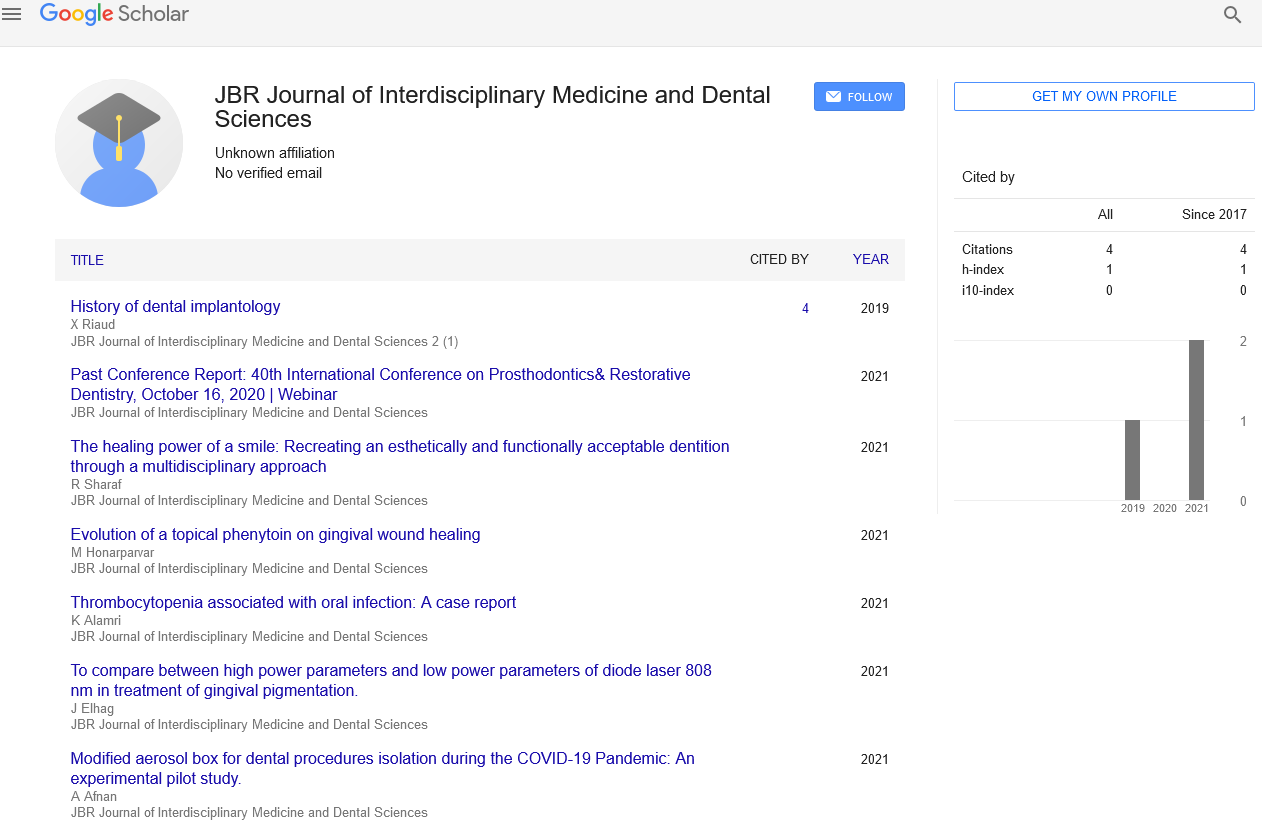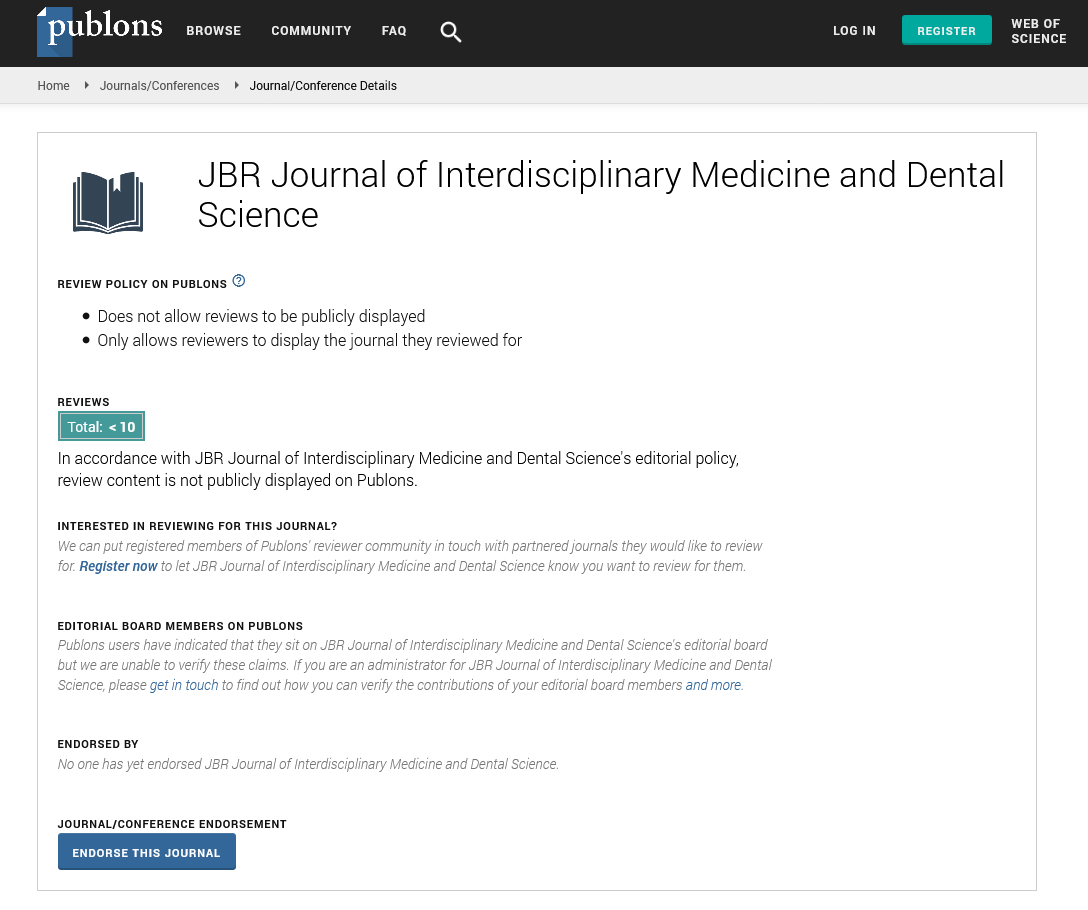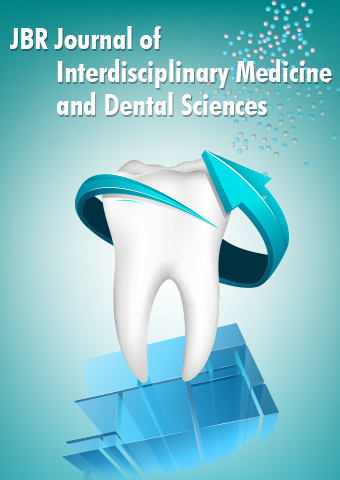Short Communication - JBR Journal of Interdisciplinary Medicine and Dental Sciences (2020) Volume 3, Issue 2
Clinical considerations and precautions for immediate loading of dental implant in extracted tooth socket
Sachin Bhalla
Dr bhallas dental superspeciality clinic, India
Abstract
In cases of Immediate loading the foremost important evaluation lies on the investigative tool either available before loading or while and before tooth is extracted with bad prognosis and clinical evaluation as las key resort in ref. to patients interest. Or in cases of delayed loading too CBCT, OPG, IOPA, BONE CALLIPERS. Of these tools for important for loading of implant . Implant placement in maxillary anterio region has most aesthetic challenges in implant dentistry because tooth loss cause bone resorption and collapse of gingival architecture, which cause aesthetic compromise and inadequate bone for implant placement. Actual implant placement into fresh extraction socket reduces the treatment time, cost, defend the gingival aesthetic and increases the refresh of the patient. This text describes the procedure for immediate implant placement in fresh extraction socket and early loading of implant with zirconia crown. Clinical and radiographic examination revealed width and length of the tooth for choosing implant size and style. Cement maintained zirconia crown was used for early packing . Implant was strongly loaded and was functional during 36 months follow up course. Immediate placing and early loading of implant provides advantages like fewer surgical action , shorter analysis time, and improved aesthetic and psychological confidence.
Achieving ideal esthetic results with dental implants may be a challenge within the maxillary anterior region. Optimal implant position, sufficient volume of hard and soft tissues, and therefore the presence of an interproximal papilla are essential. Although dental implants are used for quite 40 years to exchange missing teeth, current procedures are esthetically driven.Initial studies and protocols advocated a two-stage surgical approach requiring the implant to be submerged and free-of-load to make sure predictable healing and osseointegration. This two-stage protocol, however, involves two surgical procedures, an extended healing period, and creates professionalism challenges. As a result, immediate loading (provisionalization) of an implant at the time of placement has become a viable treatment option, particularly within the esthetic zone. When rehabilitation one or two teeth within the anterior maxilla, professionalism are often simplified by immediately loading the implant. First, we'd like to review the steps in immediate loading of an implant. The implant could also be placed into either an extraction socket or a healed site, an abutment (preferably a definitive, tooth-colored abutment) is attached, and a hard and fast provisional is placed. “Immediate load” could be seem the minima as it is big that there's no connection on the provisional in centric block or excursive change . Unlike an edentulous arch, where a edge of 4 to 6 implants are splinted for cross-arch stabilization, within the anterior maxilla, it's commonly one, lone-standing implant. Patient selection, also as surgical skill and technique, influence the result of success. These factors, however, are relevant in any sort of implant treatment modality and aren't singularly important in immediate load. Factors that influence immediate load and therefore the success of osseointegration are:
• Implant features
• Bone quality and quantity
• Initial stability
Implant features
Implant companies have modified implant designs to make implants with textured surfaces that increase area and with surface porosities that promote quicker bone formation. Secondary grooves increase the area and promote bone growth. Additionally, implants are tapered to permit for initial stability into the apical bone. These modifications also leave placement of implants in softer bone with greater initial stability.
Bone quality and quantity
The volume and density of the bone will determine whether an implant are often placed immediately or during a delayed approach. for instance , following a tooth extraction, if there's insufficient bone or poor bone quality that doesn't leave initial stabilization, then the location is grafted. Following adequate healing (four to 6 months), the implant is placed. a hard and fast provisional can then be attached at the time of implant placement during the second surgery to right away load. During the immediate-implant surgery, bone graft material could also be placed between the implant and therefore the walls of the extraction socket. This doesn't preclude placing a provisional because the implant is stabilized apically.
Extract Mobile Tooth or Grossly Decayed Tooth or Root Stump followed with Curretage. Measure length of Root Extracted from Cingulum and from Crown occlusal aspect (Crown Root Ratio) Measure the B-L Width/B.P. Width/Bone Width available. Use of Bone Callipers. Correct use of Drilling arrangement as per system used in Dental Office. Length of Root = Length of Implant
Width of Root = Width of Implant
Length of the Implant to be kept 3 to 4 mm. in need of length of Root.
Length of the Root is 13 mm then Length of Implant = 10 mm. or less as per Investigative Protocol.
Width = Implant if selected 5 mm or 4.25 or 4.00 mm
B-L = 6 to 7 or more use of divider & a measuring scale.
B-P = 7 to eight or more use of divider & a measuring scale.
Precautions
Last two drills as per Protocol shouldn't be utilized in immediate loading.
Maxilla = Bone Xpands and Implant engages.
Mandible = D1/D2/D3
Last Drill to be used as per code should be escape .
After this simply place implant in socket following inter dental bone if indicated on clinical evaluation then engage with rotation with the assistance of torque adjusting rachet as threads of most implant are self-cutting and self-drilling.
Placement of Bone Graft/Memberane/Suture
Minimum 3-6 m, site evaluation followed with medication and post op investigation before loading tooth.


